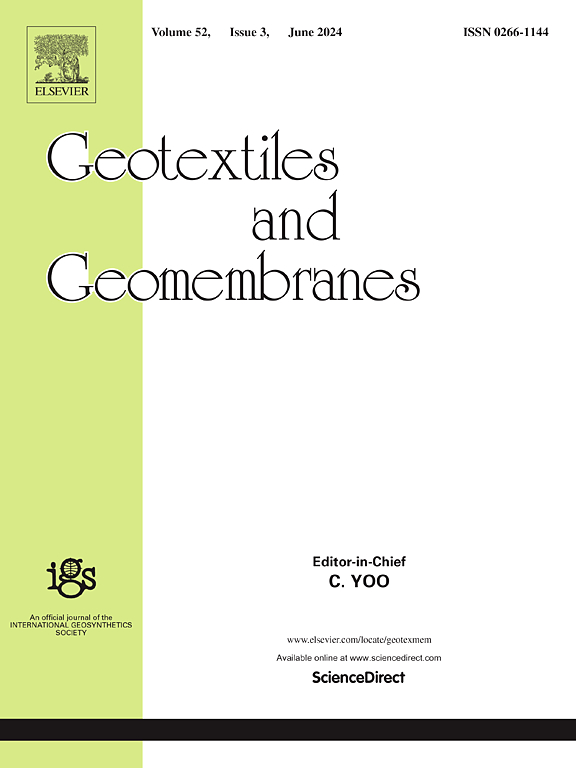Response of isolated footing on a geogrid reinforced fill and undisturbed peat subgrade soil system
IF 6.2
1区 工程技术
Q1 ENGINEERING, GEOLOGICAL
引用次数: 0
Abstract
The geotechnical behavior of undisturbed peat subgrade within geogrid-reinforced foundation systems remains inadequately understood, despite its high compressibility and engineering complexities. This study conducts a systematic investigation into the bearing capacity and settlement characteristics of an isolated footing on geogrid-reinforced fill over undisturbed peat, utilizing laboratory-scale model tests. Unlike previous studies that rely on disturbed peat samples, this research preserves natural stratification and in-situ response mechanisms, providing a more accurate representation of reinforcement performance. The results demonstrate that geogrid reinforcement enhances bearing capacity by up to 149.7 % and mitigates settlement by 79 %, with optimal reinforcement efficiency achieved at h/B = 0.3. These findings underscore the critical role of geogrid embedment depth, fill thickness, and relative density in optimizing foundation stability. By integrating undisturbed peat in physical modeling, this study bridges the gap between controlled laboratory experiments and real-world geotechnical applications, providing a framework for optimizing geosynthetic reinforcement strategies in highly compressible subgrades and paving the way for more reliable foundation designs in challenging ground conditions.
土工格栅加筋填土-原状泥炭基土体系隔震基础响应
土工格栅加固基础体系中未受扰动泥炭地基的岩土力学特性仍未得到充分的了解,尽管其具有高压缩性和工程复杂性。本研究利用实验室规模的模型试验,对未受扰动泥炭上土工格栅加筋填筑隔震基础的承载力和沉降特性进行了系统的研究。与以往依赖于扰动泥炭样品的研究不同,本研究保留了自然分层和原位响应机制,提供了更准确的加固性能表征。结果表明:加筋后土工格栅承载力可提高149.7%,沉降可降低79%,当h/B = 0.3时,加筋效率最佳;这些发现强调了土工格栅嵌入深度、填充厚度和相对密度在优化基础稳定性中的关键作用。通过将未受干扰的泥炭整合到物理模型中,本研究弥合了受控实验室实验与现实岩土工程应用之间的差距,为优化高压缩性路基的土工合成加固策略提供了框架,并为在具有挑战性的地面条件下进行更可靠的基础设计铺平了道路。
本文章由计算机程序翻译,如有差异,请以英文原文为准。
求助全文
约1分钟内获得全文
求助全文
来源期刊

Geotextiles and Geomembranes
地学-地球科学综合
CiteScore
9.50
自引率
21.20%
发文量
111
审稿时长
59 days
期刊介绍:
The range of products and their applications has expanded rapidly over the last decade with geotextiles and geomembranes being specified world wide. This rapid growth is paralleled by a virtual explosion of technology. Current reference books and even manufacturers' sponsored publications tend to date very quickly and the need for a vehicle to bring together and discuss the growing body of technology now available has become evident.
Geotextiles and Geomembranes fills this need and provides a forum for the dissemination of information amongst research workers, designers, users and manufacturers. By providing a growing fund of information the journal increases general awareness, prompts further research and assists in the establishment of international codes and regulations.
 求助内容:
求助内容: 应助结果提醒方式:
应助结果提醒方式:


